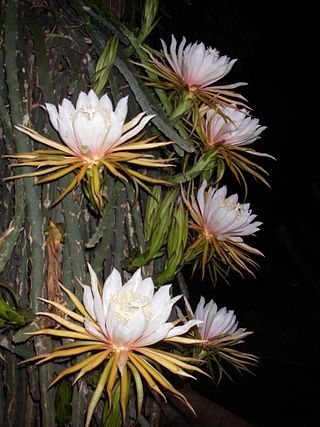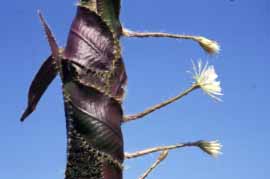
Acanthocereus is a genus of cacti. Its species take the form of shrubs with arching or climbing stems up to several meters in height. The generic name is derived from the Greek word άκανθα (acantha), meaning spine, and the Latin word cereus, meaning candle. The genus is native to the mostly tropical Americas from Texas and the southern tip of Florida to the northern part of South America, including islands of the Caribbean.

Disocactus is a genus of epiphytic cacti in the tribe Hylocereeae found in Central America, the Caribbean and northern South America. It should not be confused with Discocactus, which is a different genus.

Hylocereus is a former genus of epiphytic cacti, often referred to as night-blooming cactus. Several species previously placed in the genus have large edible fruits, which are known as pitayas, pitahayas or dragonfruits. In 2017, a molecular phylogenetic study confirmed an earlier finding that the genus Hylocereus was nested within Selenicereus, so all the species of Hylocereus were transferred to Selenicereus.

Selenicereus, sometimes known as moonlight cactus, is a genus of epiphytic, lithophytic, and terrestrial cacti, found in Mexico, Central America, the Caribbean and northern South America. The term night-blooming cereus is also sometimes used, but this is also used for many night-blooming cacti, including Epiphyllum and Peniocereus. In 2017, the genus Hylocereus was brought into synonymy with Selenicereus. A number of species of Selenicereus produce fruit that is eaten. The fruit, known as pitaya or pitahaya in Spanish or as dragon fruit, may be collected from the wild or the plants may be cultivated.

Pseudorhipsalis is genus of cacti. This genus is often included in Disocactus. It is epiphytic, many branched, and elongated with flattened, serrated cladodes. In its early life, it stands erect, but soon becomes prostrate. It produces numerous flowers.

Weberocereus is genus of cacti. It produces a green and white flower and is found mainly in Costa Rica and Nicaragua.

Deamia is a genus of cacti. Its species are native from south Mexico through Central America to Nicaragua. Its species have been placed in Selenicereus and Strophocactus.

The Cactoideae are the largest subfamily of the cactus family, Cactaceae, and are widely distributed throughout the Americas. Cactaceae is the 5th most endangered plant or animal family evaluated globally by the International Union for Conservation of Nature. Around 80% of cactus species belong to this subfamily. The genera of the Cactoideae are characterized by microscopic foliage leaves. All photosynthesis occurs in shoot cortex cells covered by a persistent epidermis and stomata. Another important characteristic of this subfamily is ribbed stems, which enable the inner cortex to expand radially without breaking the shoot surface to absorb large quantities of water.

Selenicereus costaricensis, synonym Hylocereus costaricensis, known as the Costa Rican pitahaya or Costa Rica nightblooming cactus, is a cactus species native to Central America and north-eastern South America. The species is grown commercially for its fruit, called pitaya or pitahaya, but is also an impressive ornamental vine with huge flowers. The species may not be distinct from Selenicereus monacanthus.

Aporocactus martianus is a species of cactus found in Oaxaca, Mexico.

Strophocactus brasiliensis, synonym Pseudoacanthocereus brasiliensis, is a species of plant in the family Cactaceae. It is endemic to Brazil. Its natural habitats are subtropical or tropical dry forests and hot deserts. It is threatened by habitat loss.

The Hylocereeae are a tribe of cacti. Most are found in the tropical forests of Central and northern South America, and are climbers or epiphytes, unlike most cacti. The tribe includes between six and eight genera in different circumscriptions. The plants known as "epiphyllum hybrids" or "epiphyllums", widely grown for their flowers, are hybrids of species within this tribe, particularly Disocactus, Pseudorhipsalis and Selenicereus, less often Epiphyllum, in spite of the common name.

Epiphyllum hookeri is a species of climbing cactus in the Epiphyllum genus. It forms showy white flowers and is native from Mexico through Central America to Venezuela. A perennial, it was introduced to Florida and some West Indian islands.

Strophocactus wittii, synonym Selenicereus wittii, known as the Amazon moonflower, is a species of plant in the genus Strophocactus in the cactus family (Cactaceae), and is one of several species commonly called "moonflowers". It was first described in 1900 and is one of three species of cactus found in the central Amazon basin.
Strophocactus sicariguensis, synonym Pseudoacanthocereus sicariguensis, is a species of plant in the family Cactaceae. It is native to Colombia and Venezuela. It has often sprawling thin stems and white funnel-shaped flowers that open at night.

Kimnachia is a monotypic genus of cacti. Its only species is Kimnachia ramulosa, synonym Pseudorhipsalis ramulosa, which is native from southern Mexico to northern South America and also found in Jamaica.
Deamia chontalensis is a species of flowering plant in the family Cactaceae, native to southwestern Mexico and Guatemala. It has sprawling or pendent branched stems and fragrant white flowers.

Deamia testudo is a species of flowering plant in the family Cactaceae, native from southern Mexico through Central America to Nicaragua. It was first described in 1838. It is a climber or clamberer, with long stems and large white flowers.

The Echinocereeae are a tribe of cacti in the subfamily Cactoideae. Since 2006, the tribe has included the former tribe Pachycereeae in many treatments of cactus classification. The exact circumscription of the tribe has been subject to considerable change, particularly since molecular phylogenetic approaches have been used in determining classifications, and remains uncertain. The tribe includes large treelike species, such as the saguaro, as well as shorter shrubby species. Most members of the tribe are found in desert regions, particularly in Mexico and the southwestern United States.

Epiphyllum chrysocardium is an epiphytic cactus native to Mexico, commonly called fern leaf cactus, golden heart epiphyllum, shark tooth cactus and shark fin cactus.



















